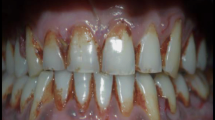Abstract
Purpose
Isolated zygomatic arch fractures (IZAFs) are habitually reduced at a distance, via a temporal approach. Open reductions are not recommended due to the associated morbidity and complications. However, performing closed reductions makes it difficult to determine whether it was done satisfactorily. This study aims to determine whether the acquisition of intraoperative images with a C-arm to evaluate IZAF reductions is a useful technique in treating such fractures.
Methods
Our hypothesis is that acquiring intraoperative images with a C-arm reduces the need for a second surgery. Between 2009 and 2012, 50 patients who were diagnosed with IZAF requiring surgery were randomly distributed into two groups: 25 patients were in the experimental group, where fracture reduction was performed and immediately corroborated intraoperatively for an adequate result using a C-arm, and 25 patients were assigned to a control group where the fracture reduction was controlled with post-surgery imaging.
Results
The results did not reveal significant differences between both groups (p = 0.5). Nevertheless, the experimental group had the advantage of being able to immediately reduce the fracture again if the result was unsatisfactory.
Conclusions
Despite the fact that the results are not statistically significant (p = 0.5), the authors recommend undertaking an intraoperative imaging analysis in areas where we are not certain of the reduction.




Similar content being viewed by others
References
Ungari C, Filiaci F, Riccardi E, Rinna C, Iannetti G (2012) Etiology and incidence of zygomatic fracture: a retrospective study related to a series of 642 patients. Eur Rev Med Pharmacol Sci 16(11):1559–1562
Marinho RO, Freire-Maia B (2013) Management of fractures of the zygomaticomaxillary complex. Oral Maxillofac Surg Clin North Am 25(4):617–636
Swanson E, Vercler C, Yaremchuk MJ, Gordon CR (2012) Modified gillies approach for zygomatic arch fracture reduction in the setting of bicoronal exposure. J Craniofac Surg 23(3):859–862
Kim J, Kim S, Chung S, Chung YK (2014) Zygomatic arch fracture: a new classification and treatment algorithm with epidemiologic analysis. J Craniofac Surg 25(4):1389–1392.
Ellstrom CL, Evans GR (2013) Evidence-based medicine: zygoma fractures. Plast Reconstr Surg 132(6):1649–1657
Xie L, Shao Y, Hu Y, et al. (2009) Modification of surgical technique in isolated zygomatic arch fracture repair: seven case studies. Int J Oral Maxillofac Surg 38(10):1096–1100
Czerwinski M, Lee C (2006) The rationale and technique of endoscopic approach to the zygomatic arch in facial trauma. Facial Plast Surg Clin North Am 14(1):37–43
Czerwinski M, Lee C (2004) Traumatic arch injury: indications and an endoscopic method of repair. Facial Plast Surg 20(3):231–238
Wilde F, Lorenz K, Ebner AK, et al. (2013) Intraoperative imaging with a 3d C-arm system after zygomatico-orbital complex fracture reduction. J Oral Maxillofac Surg 71(5):894–910
Akizuki H, Yoshida H, Michi K (1990) Ultrasonographic Evaluation During Reduction Of Zygomatic Arch Fractures. J Craniomaxillofac Surg 18(6):263–266
Woolley EJ, Jones DC (2005) The use of the image intensifier in fractures of the zygomatic arch–a technical note. Int J Oral Maxillofac Surg 34(4):440–442
Imai T, Michizawa M, Fujita G, et al. (2011) C-Arm-Guided Reduction Of Zygomatic Fractures Revisited. J Trauma 71(5):1371–1375
Czerwinski M, Parker WL, Beckman L, Williams HB (2009) Rapid intraoperative zygoma fracture imaging. Plast Reconstr Surg 124(3):888–898
Czerwinski M (2015) C-Arm Assisted Zygoma Fracture Repair: A Critical Analysis Of The First 20 Cases. J Oral Maxillofac Surg 73(4):692 E1-8
Author information
Authors and Affiliations
Corresponding author
Ethics declarations
This study was approved by the hospital ethics board, which complies with the Helsinki Declaration.
Fundings
Neither authors nor any member of our immediate family has a financial relationship or interest (currently or within the past 12 months) with any entity producing, marketing, re-selling, or distributing health care goods or services consumed by, or used on, patients.
Informed consent
The patients accepted for this study approved and signed an informed consent.
Source of support
We did not get grants from any source.
Rights and permissions
About this article
Cite this article
Pedemonte, C., Sáez, F., Vargas, I. et al. C-arm as intraoperative control in reduction of isolated zygomatic arch fractures: a randomized clinical trial. Oral Maxillofac Surg 20, 79–83 (2016). https://doi.org/10.1007/s10006-015-0531-4
Received:
Accepted:
Published:
Issue Date:
DOI: https://doi.org/10.1007/s10006-015-0531-4




